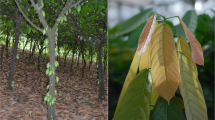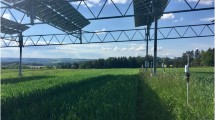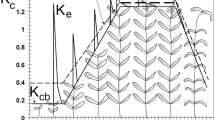Abstract
The conditions under which forages yield more under tree canopies than in open fields are not well understood. This study was conducted to determine how microclimate experienced by forages in central Appalachia is modified by black locust (Robinia pseudoacacia L.) tree canopies. The effect of tree row location relative to forage growing point was evaluated for its impact on soil water, photosynthetically active radiation (PAR), red/far-red ratio, and surface soil temperature. There was no consistent spatial dependency relating tree rows to soil water levels. While daily PAR decreased as the time under shade increased, the level of PAR under tree canopies nearly doubled as cloud cover increased from 0 to 25%. The red/far-red ratio decreased from 1.16 to 0.2 over forage growing between tree rows compared to forage within tree rows. Surface soil temperature remained nearly constant (1.5–2 °C increase) during sunny days under tree canopies but increased 8–12 °C by mid afternoon at unshaded sites depending on soil water levels. Forages under black locust trees experienced less extreme variation in both daily PAR and temperature than unshaded forages, thus reducing the metabolic cost of adaptation to extreme conditions.
Similar content being viewed by others
References
Ballare CL, Scopel AL and Sanchez RA (1990) Far-red radiation reflected from adjacent leaves: An early signal of competition in plant canopies. Science 247: 329-331
Boring LR and Swank WT (1984) The role of black locust (Robinia pseudoacacia) in forest succession. Journal of Ecology 72: 749-766
Chapman AG (1935) The effect of black locusts on associated species with special reference to forest trees. Ecological Monographs 5: 39-60
Cruz P, Sierra J, Wilson JR, Dulormne M and Tournebize R (1999) Effects of shade on the growth and mineral nutrition of tropical grasses in silvopastoral systems. Annals of Arid Zones 38: 335-361
Dawson JO, White TA, Dzialowy PJ and Herendeen RA (1982) Nitrogen accretion in surficial soil of a young plantation of Robinia pseudoacacia (p 3). Agricultural experiment station report No. 82-7. University of Illinois at Urbana-Champaign
Deregibus VA, Sanchez RA, Casal JJ and Trlica MJ (1985) Tillering responses to enrichment of red light beneath the canopy in a humid natural grassland. Journal of Applied Ecology 22: 199-206
Feldhake CM and Schumann CM (1997) Establishment of black locust in hill pastures of its native Appalachian range. Pro. 5th Conf. on Agroforestry in North America (pp 147-151). Ithaca, New York
Frank AB and Hofmann L (1994) Light quality and stem numbers in cool-season forage grasses. Crop Science 34: 468-473
Garman WH and Merkle FG (1938) Effect of locust trees upon the available mineral nutrients of the soil. Journal of The American Society of Agronomy 30: 122-124
Gillespie AR and Pope PE (1990) Rhizosphere acidification increases phosphorus recovery of black locust: II. Model predictions and measured recovery. Soil Science Society of America Journal 54: 538-541
Gustafson AF (1935) Composition of black locust leaf mold and leaves and some observations on the effects of the black locust. Journal of The American Society of Agronomy 27: 237-239
Hawke MF (1991) Pasture production and animal performance under pine agroforestry in New Zealand. Forest Ecology and Management 45: 109-118
Healey KD, Rickert KG, Hammer GL and Bange MP (1998) Radiation use efficiency increases when the diffuse component of incident radiation is enhanced under shade. Australian Journal of Agricultural Research 49: 665-672
Kasperbauer MJ and Karlen DL (1986) Light-mediated bioregulation of tillering and photosynthate partitioning in wheat. Physiologia Plantarum 66: 159-163
Kephart KD and Buxton DR (1993) Forage quality responses of C3 and C4 perennial grasses to shade. Crop Science 33: 831-837
Keresztesi B (1988) Black locust: the tree of agriculture. Outlook on Agriculture 17: 77-85
Neel LR (1939) The effect of shade on pasture. Tennessee Agricultural Agriculture 17: 77-85
Neumann IF and Pietrowiez P (1989) Light and water availability in fields with and without trees. An example from Nyabisindu in Rwanda. In: Reifsnyder WS and Darnhofer TO (eds) Meteorology and Agroforestry (pp 401-406). International Council for Research in Agroforestry, ICRAF House, Nairobi, Kenya
Sharrow SH (1991) Tree planting pattern effects on forage production in a Douglas-fir agroforest. Agroforestry Systems 16: 167-175
Sinclair TR, Shiraiwa T and Hammer GL (1992) Variation in crop radiation-use efficiency with increased diffuse radiation. Crop Science 32: 1281-1284
Smith RM (1942) Some effects of black locusts and black walnut on southeastern Ohio pastures. Soil Science 53: 385-398
Sprague VG (1943) The effect of temperature and day length on seedling emergence and early growth of several pasture species. Soil Sci Soc Am Pro 8: 287-294
Uselman SM, Qualls RG and Thomas RB (1999) A test of a potential short cut in the nitrogen cycle: The role of exudation of symbiotically fixed notrogen from the roots of a N-fixing tree and the effects of increased atmospheric CO2 and temperature. Plant and Soil 210: 21-32
Wilson JR (1996) Shade-stimulated growth and nitrogen uptake by pasture grasses in a subtropical environment. Australian Journal of Agricultural Research 47: 1075-1093
Author information
Authors and Affiliations
Rights and permissions
About this article
Cite this article
Feldhake, C.M. Microclimate of a natural pasture under planted Robinia pseudoacacia in central Appalachia, West Virginia. Agroforestry Systems 53, 297–303 (2001). https://doi.org/10.1023/A:1013331628494
Issue Date:
DOI: https://doi.org/10.1023/A:1013331628494




